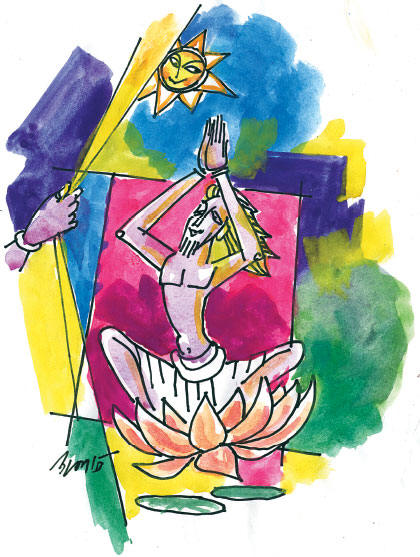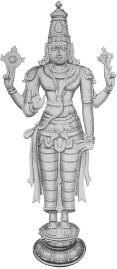Sakthi Vikatan
11 Nov, 2014
Author:
Kaivalliya Navanītham
P.N. Parasuraman. Images:
Nataṉam
Town after town there is a plethora of five-star hotels. Only the lucky
hotel guests, a few among the general population, enjoy visiting inhouse
Game & Entertainment Centers. Everyone has the ardent desire to visit
those places at least once in their lifetime.
The reception desk gives all the details and prices of the centers of
entertainment.
Just like the wannabe hotel guests, some can enjoy the ecstasy of the
soul by reading spiritual books; there are many others lacking the
opportunity and wanting to become familiar with spiritual knowledge.
Spiritual books in the preface or introduction has essential information
about the book. That is called ‘Pāyiram.’
Pāyiram can be compared to the
reception desk which dispenses a plethora of information about the
hotel.
But, there is a monumental difference between the two.
In the five-star hotel, the guest enjoys the music, dance…for the
duration of his stay on the dance floor.
Once you leave the premises, you get a sense of letdown. He says
to himself, ‘I blew the money for a one-day jaunt to the hotel.’ We
suffer mental anguish. That short-lived happiness was done with and
vanished. The reception
desk (= Introduction) of the spiritual book gives undiminished pleasure
always, as you dig and delve into it.
In the beginning, the middle, the end and beyond, the book’s spiritual
essence permeates your being and continually gives a fulfilling ecstasy;
revitalization of your soul is palpable.
Kaivalliya Navanītham
gives you energy and enthusiasm.
Let us go to the drawing room, where a warm reception awaits us. Let us
peek into the Pāyiram.
At the entrance gate, Kaivalliya Navanītham has seven verses. Thāṇḍavamūrthy
Swāmigaḷ,
the author of the treatise, is a scholar in Sanskrit and a proven
researcher. He composed this book with a benignant view that everyone
should have the divine experience (he had) and live in
bliss (rapturous joy).
For auspicious conclusion of the nascent book as a service to the
public, invocation is the first part. The author’s corner expresses the
author’s desire…in a subtle manner. The introductory presentation turns
our attention to the author and the treatise.
The spiritual writings say that God is omnipresent. In the first
invocatory verse, the author begins the treatise making a reference to
us.
பொன் நிலம் மாதர் ஆசை பொருந்தினர்
பொருந்தார் உள்ளம்
தன்னில் அந்தரத்தில் சீவ சாக்ஷி
மாத்திரமாய்
நிற்கும்.
The verse: The Lusters of Gold, Land and Woman and the anchorite.
In
their individual souls, God stands as The Witness. Let us worship his
feet.
Despite the differing stance of the lusters and the anchorites, the
Supreme Soul brooking no division or discrimination, takes irrevocable
residence in all the souls. Such was the beautiful presentation of the
author of the verse.
Continued… ‘That
Parabrahmam does the three functions of creation, maintenance and
destruction, appearing as three divinities. Braḥmam is of many forms.
God as the Sun of Wisdom (=
ஞான சூரியன்)
rising from the ocean of ecstasy is Braḥmam. That which shines as the
form of wisdom is Braḥmam.
That kind of Braḥmam, I worship,’ says the author.
Braḥmam depicted as Sun of Wisdom is surprising.
The sun, we know of, is the
bringer of day beginning with dawn and of night upon dusk. The physical
sun appears and disappears from sight. But the Sun of Wisdom has no such
thing, neither a beginning, nor an end.
When we read or hear the verse, it appears we seem to understand it to a
certain extent. When you
receive it through experience, darkness envelops it.
If we have a screen between the sun and us, the sun disappears from our
sight. Is it not so? Likewise, there is an illusory screen in us that
hides the Sun of Wisdom from our sense of realization.
When someone lifts the obscuring screen, we can see the sun. Likewise,
when the Gurunāthar lifts the screen of evil Guṇas
and intellectual obscuration, we can obtain Darśan of Sun of Wisdom.
The poet says, “To the sacred feet of Gurunāthar, who gives me God’s
Grace and inculcates the state of Braḥmam in me, I pay homage and
worship.”
‘I bring to the attention of the pupils, incapable of researching the
extensive Vedanta Sastras and present it to them with clarity (and
brevity). It is the essence of Upanishads, this Kaivalliya Navanītham,
obtained by the medium of personal experience, which I offer to all.
This is capable of removing sensual torment.’
Offering homage and worship to the ‘Upāsaṉā Mūrthy,’ he completes the
Pāyiram. Thāṇḍavamūrthy Swāmigaḷ
says, ‘I offer worship to my enslaving God Venkatasalapathy AKA Tirumal.
He explains Kaivalliya Navanītham in two parts: Tattva Exposition and
Clearing the doubts.’
'முத்தனை
வேங்கடேச முகுந்தனை
எனை ஆட்கொண்ட
கத்தனை வணங்கிச் சொல்லும்
கைவல்ய நவநீதத்தைத்
தத்துவ விளக்கம் என்றும்
சந்தேகம் தெளிதல் என்றும்
வைத்து இரு படலமாக
வகுத்து உரை செய்கின்றேனே!’
Come…Let us elucidate ‘Tattva Exposition.’
Will continue…

